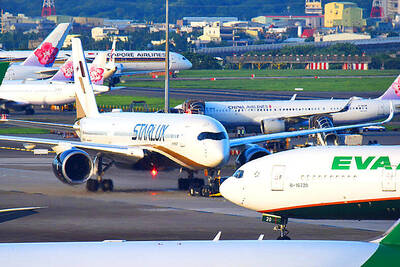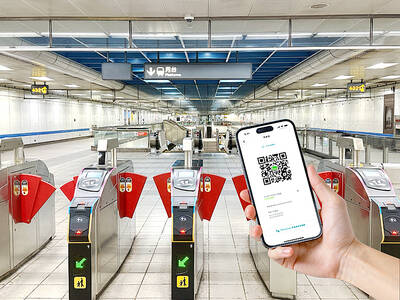The Chinese navy has commissioned three new amphibious transport docks over the past few years that could improve Beijing’s ability to seize and hold Taiwan’s outlying islands.
According to a report to be unveiled by the US House Armed Services Committee yesterday, each of the docks can carry a mix of air-cushion landing craft, amphibious armored vehicles, helicopters and marines.
Nevertheless, the report says that “at this time” China does not appear to be pursuing the amphibious capabilities necessary to conduct a large-scale invasion of Taiwan.
The docks, described as “large amphibious ships,” are part of a general expansion by the People’s Liberation Army Navy (PLA Navy) detailed in the China Economic and Security Review Commission’s recently completed annual report to the US Congress.
A full committee hearing led by representatives Randy Forbes and Colleen Hanabusa is to consider the report, its findings, conclusions and its recommendations.
A draft copy of the report has been the subject of various stories carried by the Taipei Times over the past week.
The report says that the PLA Navy has about 75 major surface combatants, 85 missile patrol boats and 60 conventional and nuclear submarines.
“These units are available for a range of missions — such as enforcing a blockade of Taiwan,” the report says.
“As China’s naval modernization continues, an increasing percentage of these ships and submarines will feature advanced weaponry,” it says.
“In contrast, the Taiwan Navy has 26 major surface combatants, 45 missile patrol boats and two operational submarines,” it adds.
The report says that Taiwan began work on a prototype of a new class of catamaran-style missile corvette in November last year and plans to build up to 11 of them by next year.
“The new ship will carry long-range antiship cruise missiles and feature better sea-keeping ability, range and endurance compared with Taiwan’s current patrol fleet,” the report says.
“In a potential conflict with China, the corvette will enhance the lethality and survivability of Taiwan’s anti-surface force,” it says.
In addition, the report says, Taiwan has deployed its long-delayed Ray Ting (RT)-2000 multiple-launch rocket system.
“In a potential Chinese invasion, the RT-2000 will provide Taiwan with quick-fire capability against Chinese amphibious ships as they cross the Taiwan Strait,” the report says.
“With a range of up to 25 miles [40.2km] and a wheeled chassis allowing for easy maneuverability, the RT-2000 is a significant improvement over its predecessor, the Kung Feng V1,” the report adds.
The Armed Services Committee will hear that Taiwan’s defense spending likely “will remain stagnant” through at least the end of President Ma Ying-jeou’s (馬英九) term in office in 2016.
“President Ma has little incentive to increase the defense budget, since improved cross-strait relations have reduced public perceptions of the China threat in attempts to recover from the global financial crisis,” the report says.
“US officials and outside observers suggest that if this trend continues, then the Taiwan military may struggle to maintain a credible deterrent capability,” it adds.

Trips for more than 100,000 international and domestic air travelers could be disrupted as China launches a military exercise around Taiwan today, Taiwan’s Civil Aviation Administration (CAA) said yesterday. The exercise could affect nearly 900 flights scheduled to enter the Taipei Flight Information Region (FIR) during the exercise window, it added. A notice issued by the Chinese Civil Aviation Administration showed there would be seven temporary zones around the Taiwan Strait which would be used for live-fire exercises, lasting from 8am to 6pm today. All aircraft are prohibited from entering during exercise, it says. Taipei FIR has 14 international air routes and

Taiwan lacks effective and cost-efficient armaments to intercept rockets, making the planned “T-Dome” interception system necessary, two experts said on Tuesday. The concerns were raised after China’s military fired two waves of rockets during live-fire drills around Taiwan on Tuesday, part of two-day exercises code-named “Justice Mission 2025.” The first wave involved 17 rockets launched at 9am from Pingtan in China’s Fujian Province, according to Lieutenant General Hsieh Jih-sheng (謝日升) of the Office of the Deputy Chief of the General Staff for Intelligence at the Ministry of National Defense. Those rockets landed 70 nautical miles (129.6km) northeast of Keelung without flying over Taiwan,

City buses in Taipei and New Taipei City, as well as the Taipei MRT, would on Saturday begin accepting QR code payments from five electronic payment providers, the Taipei Department of Transportation said yesterday. The new option would allow passengers to use the “transportation QR code” feature from EasyWallet, iPass Money, iCash Pay, Jkopay or PXPay Plus. Passengers should open their preferred electronic payment app, select the “transportation code” — not the regular payment code — unlock it, and scan the code at ticket readers or gates, General Planning Division Director-General Liu Kuo-chu (劉國著) said. People should move through the

The Ministry of National Defense (MND) today released images of the military tracking China’s People's Liberation Army (PLA) movements during the latest round of Chinese drills around Taiwan. The PLA began "Justice Mission 2025" drills today, carrying out live-fire drills, simulated strikes on land and maritime targets, and exercises to blockade the nation's main ports. The exercises are to continue tomorrow, with the PLA announcing sea and air space restrictions for five zones around Taiwan for 10 hours starting from 8:30am. The ministry today released images showing a Chinese J-16 fighter jet tracked by a F-16V Block 20 jet and the